Further information about AGE-Reader
Our phone hotline:
+49 931 32933-22
We will be pleased to consult you on the selection of the proper instrument model, optimally suited to your application.
AGEs – Advanced Glycation Endproducts
AGEs play a pivotal role in the development of chronic metabolism and age related diseases such as diabetes, renal failure and cardio-vascular disease.
The level of AGEs in long-lived tissue – not in blood – serves as a memory of glyco-metabolic and oxidative stress. Hence AGEs mirror the process in disease advancement and act as strong predictors, in particular of cardio-vascular complications. Gradually accumulating over a human lifetime this progression is enhanced in patients with conditions such as diabetes mellitus, renal failure, or cardio-vascular disease1.
Accumulation of tissue AGEs is also indicative in metabolic disease related complications such as early kidney, eye, and nerve impairments. Clinically AGEs can be used in the risk assessment of future cardio-vascular morbidity and mortality2. New drugs, aimed at preventing formation of AGEs or braking AGEs, are under development and may be available in the near future.
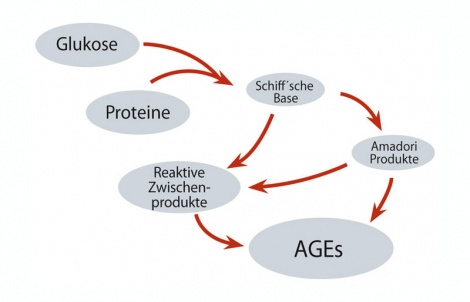
Clinical Applications
- Assessment of individual cardio-vascular risk
- Identification of high risk patients
- Therapy follow-up and optimization
- Reduction of cost and side effects of drugs
- Monitoring of intensive care patients
- Monitoring of dialysis and transplant patients
- Risk profiling in public and corporate health programs

Comprehensive Validation
AGE reader has been validated against skin biopsy, still serving as a gold standard, in clinical settings13. Its clinical value has been proven in several large scale studies involving thousands of patients with diabetes, cardio-vascular disease and renal failure3456. AGE Reader is backed by broad scientific literature, a knowledge base covering more than ten years.
AGEs Reader in Research
- Clinical studies
- Diabetes
- Renal failure and kidney disease
- Cardio-vascular disease
- Drug studies
- Nutritional research
- Ageing research
- Skin care research
- Epidemiological studies
- Screening programs
AGE Reader for Individual Risk Stratification
Diabetes
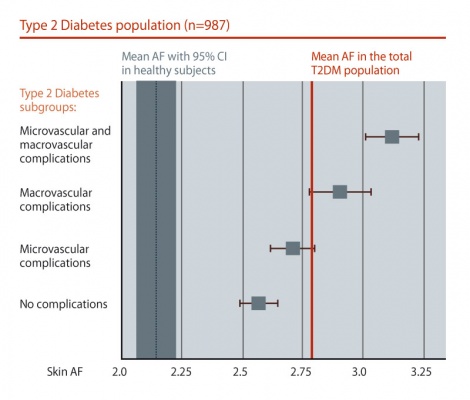
Renal Disease
- Independent predictor of cardio-vascular disease related mortality in dialysis patients4.
- Strong independent predictor of mortality and craft loss in renal transplant recipients8.
- AGEs correlate with arterial stiffness and diastolic function in both, hemodialysis and peritoneal dialysis patients914.
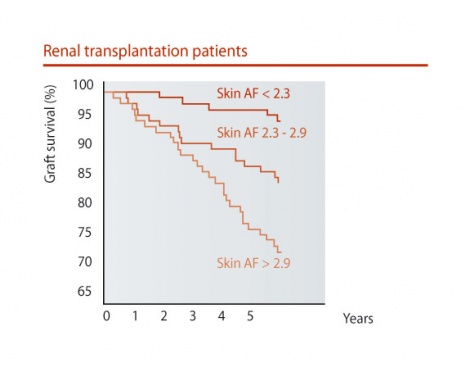
Cardio-Vascular Disease
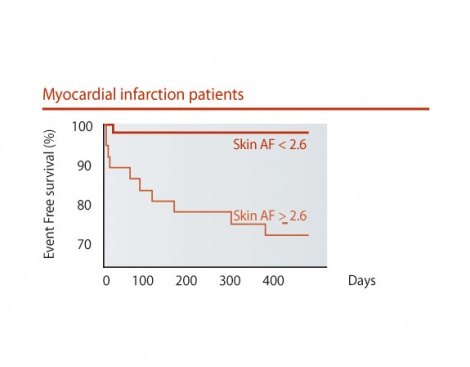
Enhancing Risk Prediction of SCORE, Framingham, UKPDS, IMT
- Viable and economical assessment tool enhancing conventional risk engines2.
- Related to early IMT increase and atherosclerosis (cardio-vascular morbidity and mortality), independent of conventional risk scores and engines1215.
- AGEs are indicative of pathogenic pathways not covered by conventional risk scores16.
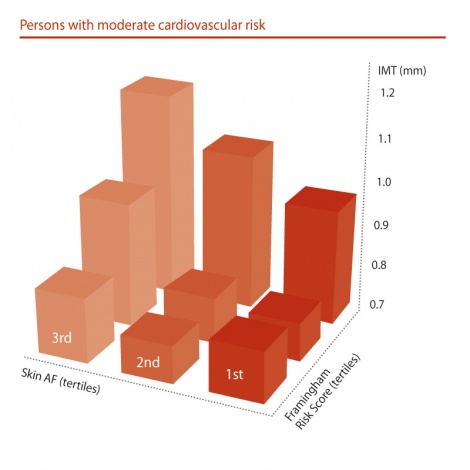
Literature:
1 Meerwaldt R et al. Cardiovascular Diabetology 2008; 7: 29
2 Lutgers HL et al. Diabetologia 2009; 52(5): 789-797
3 Lutgers HL et al. Diabetes Care 2006; 29(12): 2654-2659
4 Meerwaldt R et al. J Am Soc Nephrol 2005; 16: 3687-3693
5 Meerwaldt R et al. Diabetologia 2005; 48: 1637-1644
6 Meerwaldt R et al. Ann N Y Acad Sci 2005; 1043: 299-307
7 Gerrits E et al. Diabetes Care 2008; 31(3): 517-521
8 Hartog J et al. Transplantation 2009; 87: 1069-1077
9 Ueno H et al. Metabolism Clin Exp 2008; 57(10): 1452-1457
10 Mulder DJ et al. Circulation 2005; 112:II-371
11 Mulder DJ et al. Netherlands Heart J 2009; 17(4); 162-168
12 Meerwaldt R et al. Eur J Vasc Endovasc Surg 2008; 36(2) 125-131
13 Meerwaldt R et al. Diabetologia 2004; 47: 1324-1330
14 Hartog J et al. J Card Failure 2008; 14(17): 596-602
15 Mulder DJ et al. Artherosclerosis 2008; 197(1): 217-223
16 Smit AJ at al. Cur Med Chem 2004;11: 1241-1253
